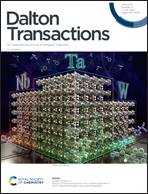Guest-induced magnetic exchange in paramagnetic [M2L4]4+ coordination cages†
Abstract
Paramagnetic complexes that possess magnetically switchable properties show promise in a number of applications. A significantly underdeveloped approach is the use of metallocages, whose magnetic properties can be modulated through host–guest chemistry. Here we show such an example that utilises a simple [CuII2L4]4+ lantern complex. Magnetic susceptibility and magnetisation data shows an absence of exchange in the presence of the diamagnetic guest triflate. However, replacement of the bound triflate by ReBr62− switches on antiferomagnetic exchange between the Cu and Re ions, leading to an S = 1/2 ground state for the non-covalent complex [ReBr62−⊂CuII2L4]2+. Comparison of this complex to a “control” palladium-cage host–guest complex, [ReBr62−⊂PdII2L4]2+, shows that the encapsulated ReBr62− anions retain the same magnetic anisotropy as in the free salt. Theoretically calculated spin-Hamiltonian parameters are in close agreement with experiment. Spin density analysis shows the mode of interaction between the CuII and ReIV centres is through the Re-Br⋯Cu pathway, primarily mediated through the Cu(dx2−y2)|Brsp|Re(dyz) interaction. This is further supported by overlap integral calculations between singly occupied molecular orbitals (SOMOs) of the paramagnetic ions and natural bonding orbitals analysis where considerable donor-to-acceptor interactions are observed between hybrid 4s4p orbitals of the Br ions and the empty 4s and 4p orbitals of the Cu ions.
![Graphical abstract: Guest-induced magnetic exchange in paramagnetic [M2L4]4+ coordination cages](/en/Image/Get?imageInfo.ImageType=GA&imageInfo.ImageIdentifier.ManuscriptID=D2DT01385A&imageInfo.ImageIdentifier.Year=2022)
- This article is part of the themed collection: Open Access in Dalton Transactions


 Please wait while we load your content...
Please wait while we load your content...